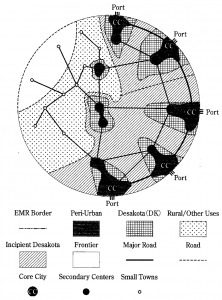The Sustainability Challenge of a Growing Megacity
Cities today face a unique set of challenges, situated in the intersections between unsustainable economic practices, growing demographic pressures, and increasing densification. UN-HABITAT notes that “between 1950 and 2005, the level of urbanization increased from 29 per cent to 49 per cent, while global carbon emissions from fossil-fuel burning increased by almost 500 per cent” (World Cities Report 2016). While the global economy faces a crisis of sustainability, cities have an answer: density, urbanization, and sustainable urban planning can, perhaps literally, pave the way to a sustainable future.
Focus: Jakarta
Jakarta represents a unique case in the area of sustainability. Situated in the context of a greater Indonesian shift away from a rural, agrarian economy during a simultaneous growth in population, Jakarta has had to come to grips with Indonesia’s declining food production despite contrasted against an increasing population. As the GDP from rural agriculture continues to shrink, various forms of production – including imports and government-sponsored farming projects — take its place. Urban farming is a particularly interesting part of this process because it subverts traditional binaries: urban/rural, service/agriculture, consumption/production. Consequently, urban farming is a constantly evolving and unique form of urban production.
In Jakarta, the fringes of the city are also the locations of complex ‘desakota’ regions. The desakota, a term coined by McGee, is an area in which there is an “intense interaction between urban and rural processes . . . as urbanization proceeds, [the desakota] will be a major force in changing the spatial structure of these regions” (McGee 2009, p. 164). Consequently, discussion of desakotas are integral to an analysis of sustainability of food systems in Jakarta.
The practice of desakota farming allows a dense urban settlement to coexist with subsistence and other farming. Due to its high population and limited land space, as well as historical migratory patterns, Jakarta’s desakota practice is a way for predominantly low-income families and individuals to produce enough food to sustain themselves independently of the nation’s food system. As an alternative to contemporary mass farming techniques, this practice suggests another way to develop local food security and productive capacity.

Theoretical Asian city including Desakota land use distribution. Source: McGee 2008, 164.
What to Expect from this Blog
In our case study, we will seek to define parameters for sustainability in urban farming and food production. Using the notion of Urban and Peri-Urban Agriculture (UPA), we will examine Jakarta’s desakota model and tease out its strengths and weaknesses. From there forward, we will take lessons learned from desakota farming and see if they can be applied elsewhere in the world. Keeping in mind that historically flows of knowledge and expertise have gone North to South, we will privilege a lens in which the global North can learn from the global South.
References:
McGee, T. G. “Managing the rural–urban Transformation in East Asia in the 21st Century.” Sustainability Science, vol. 3, no. 1, 2008, pp. 155-167, doi:10.1007/s11625-007-0040-y.
United Nations Human Settlements Programme (UN-HABITAT). “World Cities Report 2017.” Published by UN-HABITAT, 2016. Available at http://wcr.unhabitat.org/wp-content/uploads/2017/02/WCR-2016-Full-Report.pdf